
Philately is the study of postage stamps and postal history. It also refers to the collection and appreciation of stamps and other philatelic products. Philately involves more than just stamp collecting or the study of postage; it is possible to be a philatelist without owning any stamps. For instance, the stamps being studied may be very rare or reside only in museums.
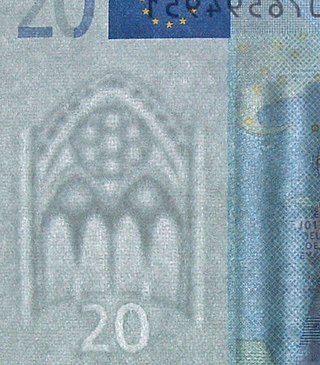
A watermark is an identifying image or pattern in paper that appears as various shades of lightness/darkness when viewed by transmitted light, caused by thickness or density variations in the paper. Watermarks have been used on postage stamps, currency, and other government documents to discourage counterfeiting. There are two main ways of producing watermarks in paper; the dandy roll process, and the more complex cylinder mould process.

For postage stamps, separation is the means by which individual stamps are made easily detachable from each other.
In philately, gum is the substance applied to the back of a stamp to enable it to adhere to a letter or other mailed item. The term is generic, and applies both to traditional types such as gum arabic and to synthetic modern formulations. Gum is a matter of high importance in philately.

The postal and philatelic history of Canada concerns postage of the territories which have formed Canada. Before Canadian confederation, the colonies of British Columbia and Vancouver Island, Prince Edward Island, Nova Scotia, New Brunswick and Newfoundland issued stamps in their own names. The postal history falls into four major periods: French control (1604–1763), British control (1763–1841), colonial government control (1841–1867), and Canada, since 1867.
Postage stamp reuse is the technique of fraudulently reusing postage stamps from sent mail to avoid paying the cost of postage.
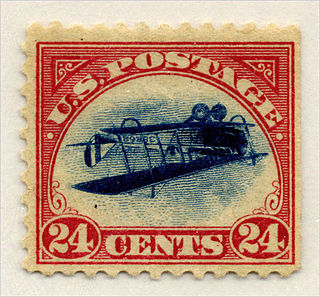
In philately, errors, freaks, and oddities (EFO) collectively refers to the wide variety of mistakes that can happen in the production of postage stamps. It encompasses everything from major design errors to stamps that are just poorly printed and includes both some of the most sought-after and expensive of all stamps and others that attract the attention of only a few specialists.

A self-adhesive stamp is a postage stamp with a pressure-sensitive adhesive that does not require moistening in order to adhere to paper. They are usually issued on a removable backing paper.

The British Central Africa Protectorate existed in the area of present-day Malawi between 1891 and 1907.
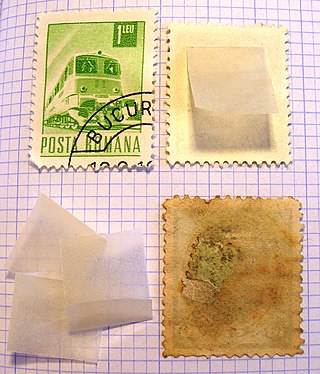
In philately, stamp hinges, or mounts, are small, folded, transparent, rectangular pieces of paper coated with a mild gum. They are used by stamp collectors to affix postage stamps onto the pages of a stamp album.

An adhesive label or sticky label is a small piece of paper designed to be affixed to any surface, typically by the action of removing a layer of adhesive on the front or back of the label. The term adhesive refers to a sticky substance, while something that is self-adhesive implies that it will stick without wetting or the application of glue to the product.
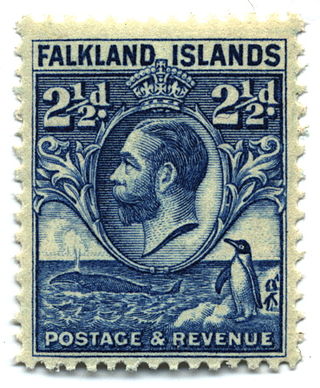
Topical or thematic stamp collecting is the collecting of postage stamps relating to a particular subject or concept. Topics can be almost anything, from stamps on stamps, birds, trains and poets on stamps, to famous physicians and scientists, along with historical people and events on stamps, which is often a standard theme for many stamp issuing countries.

This is a survey of the postage stamps and postal history of Romania.

In general, philatelic fakes and forgeries are labels that look like postage stamps but have been produced to deceive or defraud. Learning to identify these can be a challenging branch of philately.

The postal history of San Marino can be traced to October 7, 1607, with the introduction of public postal services. The republic's postal needs were handled by a post office in nearby Rimini, Italy; the first San Marino post office opened in 1833.

Postal history in the territory that now constitutes Latvia began during the 13th century, when the Archbishopric of Riga was included to the area of postal operations of the Monastic state of the Teutonic Knights and the Hanseatic League. In 1580 the Hanseatic League issued their first known regulations on courier work and payroll, regulations that also were active in the territory that now constitutes Latvia.

Philatelic expertisation is the process whereby an authority is asked to give an opinion whether a philatelic item is genuine and whether it has been repaired or altered in any way.

Postage stamp paper is the foundation or substrate of the postage stamp to which the ink for the stamp's design is applied to one side and the adhesive is applied to the other. The paper is not only the foundation of the stamp but it has also been incorporated into the stamp's design, has provided security against fraud and has aided in the automation of the postal delivery system.

The St. Louis Bears are a set of Provisional stamps issued by the St. Louis Post office in 1845-46 to facilitate prepayment of postal fees at a time when the United States Post Office had not yet issued postage stamps for national use. St. Louis, whose postmaster, John M. Wimer, instigated the production, was one of eleven cities to produce such stamps. Bears were offered in three denominations: 5¢, 10¢ and 20¢; the earliest known postmark date on a stamp of the issue is November 13, 1845.
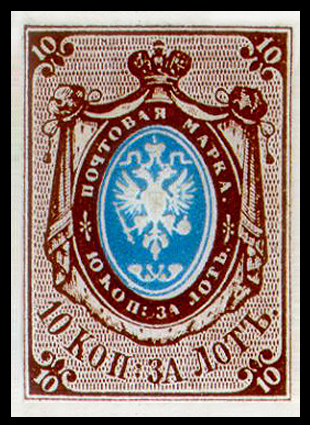
The first stamp of the Russian Empire was a postage stamp issued in 1857 and introduced within the territory of the Russian Empire in 1858. It was an imperforate 10-kopeck stamp depicting the coat of arms of Russia, and printed using typography in brown and blue.


















